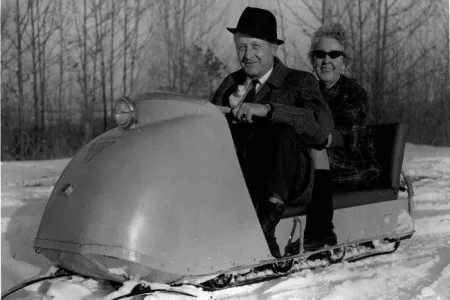Known by some as the horseback-riding president, Howard Dillingham rode into Ithaca College's history not only as its fourth leader, but also as the person who led its largest transformation since the College's inception as the Ithaca Conservatory of Music.
Dillingham came to Ithaca College in 1951 as assistant to then president Leonard Job. The newcomer's focus was on development and alumni affairs. In 1953 he was promoted to vice president, with duties that centered on instruction, faculty, and student affairs.
As president, Dillingham led the College's move from a collection of classrooms scattered throughout downtown Ithaca to its present home on the city's South Hill. This was done by borrowing $30 million over the course of five years. In addition, the Friends of Ithaca College were instrumental in the College's fund-raising cause. To recognize their generous support, College administrators named the first academic building Friends Hall. So amazing was the College's transformation that it caught the attention of Time magazine. The May 14, 1965, issue heralded the accomplishment, stating the move was completed despite the College's having "no endowment, no dependable support from foundations or industry, and only 4,000 alumni (most of them unaffluent teachers)."
The magazine went on to note how Dillingham took control of the school and made it into a national model of higher education. This was done, in part, through his "paring many elective courses to concentrate staff to an unusual degree on interdisciplinary studies, which attracted national notice." Dillingham raised tuition and upgraded faculty salaries: they increased from $3,900 in 1953 to $10,000 by 1965, according to Time. The president also substantially raised admissions standards while increasing undergraduate enrollment, more than doubled the size of the faculty, and expanded the academic program from 17 to 36 four-year curricula divided between professional and liberal studies. In 1967 the Pratt Institute and Alfred University awarded Dillingham honorary doctorates for his leadership and imagination in creating the new campus and expanding the academic program at the College. In tribute to Dillingham's accomplishments, the College's administrators dedicated the performing arts building in Dillingham's name in 1973. They also awarded him an honorary doctor of law degree in 1979.
Born October 11, 1904, in Elba, New York, Dillingham embarked on an educational path that took him away from, then back to, academia. He graduated in 1927 from the Wharton School at the University of Pennsylvania. He worked as a merchandising manager for the Gorham Company in Providence, Rhode Island, before entering the field of education as the director of the Auburn Collegiate Center, now Auburn Community College, in 1933. After receiving from Syracuse University a master of science degree in 1936 and a doctorate in education in 1938, Dillingham served as dean of Rider College in Trenton, New Jersey, until 1944. From 1944 to 1950, he served as headmaster of the Manlius School in Manlius, New York, followed by a stint in 1950-51 as headmaster of Riverside Military Academy in Gainsville, Georgia.
The Ithaca College Board of Trustees elected Dillingham to its membership in 1970 after he retired from the presidency. The board also conferred on him the title of president emeritus, making Dillingham the College's first president to hold such a distinction.
Having been active in community organizations while president, Dillingham remained involved with several local organizations, including the Ithaca City School District Board of Education, Tompkins Trust Company, Rotary (life membership), and the Ithaca Festival. In 1970 the Historic Ithaca Association awarded Dillingham and his wife Dorothy its annual award of merit for their efforts in moving the College to South Hill, as well as "their interest in preserving historic houses in the central part of the city."
The organization's citation also noted, "You cannot love the future without loving the past, and those who build for the future in harmony with the past, as the Dillinghams have done, deserve much credit."
President Dillingham died April 25, 1998, in Missoula, Montana.
